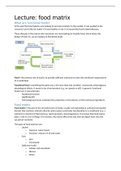Summary
Summary Lecture food matrix Food and Ingredient Categories, Carrier Systems and Food Technology HFV1004
- Module
- Institution
Summary of 12 pages for the course Food and Ingredient Categories, Carrier Systems and Food Technology HFV1004 at UM (Food matrix lecture)
[Show more]












